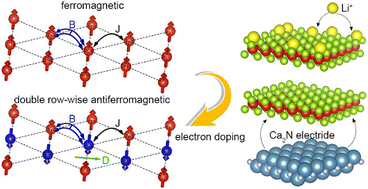Exchange interactions in the 1T-VSe2 monolayer and their modulation via electron doping using alkali metal adsorption and the electride substrate†
Abstract
The modulation of exchange interactions in layered magnets has fundamental research value and potential applications in spintronics. Based on first-principles calculations, the exchange interactions in the experimentally controversial room-temperature ferromagnetic 1T-VSe2 monolayer are systematically studied. It is found that three shells of nearest-neighbor Heisenberg exchange interactions and higher-order interactions are crucial for an accurate description of the magnetism and its thermal stability in the 1T-VSe2 monolayer. Based on our understanding of tuning the magnetic interactions and the magnetic ground state in the 1T-VSe2 monolayer via external factors, two modulation methods, involving adsorption of the alkali metal lithium and the electride Ca2N substrate, are proposed. In both Li-VSe2 and VSe2/Ca2N systems, the strongly frustrated Heisenberg exchange interaction competes with the Dzyaloshinskii–Moriya interaction and magnetocrystalline anisotropy, leading to complex magnetic ground states, such as antiferromagnetic spin spiral and periodic antiferromagnetic cycloidal states. Moreover, the higher-order exchange interactions play a crucial role in the stabilization of long-range double-row-wise antiferromagnetic states in Li-VSe2 and VSe2/Ca2N. These results highlight the effective manipulation of exchange interactions in two-dimensional magnets.



 Please wait while we load your content...
Please wait while we load your content...